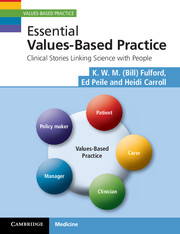Book contents
- Frontmatter
- Review quotes
- Contents
- Foreword
- Acknowledgements
- A bold claim to start this book
- Prologue: linking science with people
- Part 1 Values, individuals and an overview of values-based practice
- Part 2 The clinical skills for values-based practice
- Part 3 Relationships in values-based practice
- Part 4 Science and values-based practice
- Part 5 Bringing it all together
- Postcript: the small change of care
- A bold claim to end this book
- Appendix A Values-based practice summary and definitions of key terms
- Appendix B Values-based practice teaching framework
- Index
Prologue: linking science with people
Published online by Cambridge University Press: 05 June 2012
- Frontmatter
- Review quotes
- Contents
- Foreword
- Acknowledgements
- A bold claim to start this book
- Prologue: linking science with people
- Part 1 Values, individuals and an overview of values-based practice
- Part 2 The clinical skills for values-based practice
- Part 3 Relationships in values-based practice
- Part 4 Science and values-based practice
- Part 5 Bringing it all together
- Postcript: the small change of care
- A bold claim to end this book
- Appendix A Values-based practice summary and definitions of key terms
- Appendix B Values-based practice teaching framework
- Index
Summary
A young woman with schizophrenia finds a turning point towards recovery when a new member of the mental health team recognizes and acknowledges her aspirations.
A middle-aged car sales manager finally engages positively with evidence-based management of his hypertension when a cardiologist appointed through his firm's occupational health scheme links the need for treatment to his ambitions as an amateur racing car enthusiast.
A young couple at risk of being torn apart by conflicting views over IVF are reconciled when their parish priest helps them to understand the real rather than fancied implications of the techniques being proposed by the local infertility clinic.
These are some of the stories – based on those of real people, although biographically disguised – that are at the heart of this book. Each story presents a familiar clinical problem; for each problem, there are a variety of possible evidence-based solutions, but in each case matching solution to problem depends critically on engaging with the values of those concerned.
Values, evidence and complexity
There is nothing new as such about values in medicine. The Hippocratic Oath, on which modern codes of practice still draw, goes back over 2000 years. There is similarly nothing new as such about evidence in medicine. David Sackett and his colleagues, in their early and still influential Evidence-Based Medicine: How to Practice and Teach EBM, to which we will be returning at several points in this book, locate what is possibly the earliest recorded use of evidence-based methods in ancient Chinese medicine.
- Type
- Chapter
- Information
- Essential Values-Based PracticeClinical Stories Linking Science with People, pp. xiii - xviPublisher: Cambridge University PressPrint publication year: 2012



